Accepted Scientific Name: Argyroderma crateriforme (L. Bolus) N.E.Br.
Gard. Chron. 1926, Ser. III. lxxix. 268.
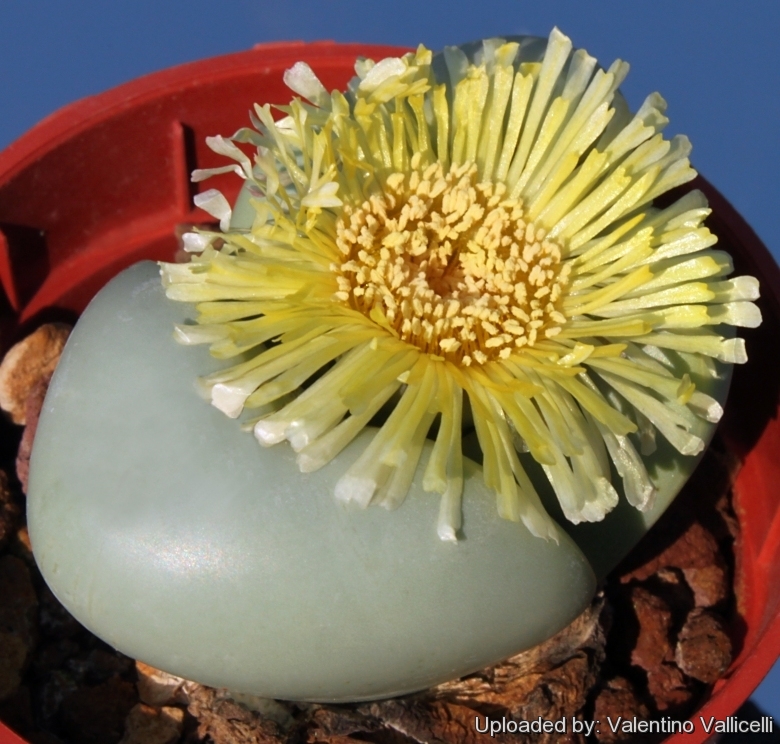
Mesembryanthemum crateriforme (Argyroderma crateriforme) Photo by: Valentino Vallicelli
Origin and Habitat: Argyroderma crateriformeSN|14671]]SN|14671]] occur in large numbers in the Knersvlakte, a unique Centre of Endemism in the Succulent Karoo Region, West Cape (Vanrhyndorp and Vredendal Districts), of South Africa. In distribution A. crateriforme lies between Argyroderma congregatum and Argyroderma delaetii.
Habitat and ecology: Plants are typically found in deep, acidic, non-saline soils with some quartz pebbles, but they are not restricted to them, they are often found on other rocky habitats as well. Argyroderma crateriformeSN|14671]]SN|14671]] is a characteristic element of the community but also Tetragonia verrucosa (Aizoaceae), Gazania krebsiana (Asteraceae), and Hirpicium alienatum (Asteraceae), and Conophytum calculusSN|21981]]SN|21981]] (mesemb) occur here. The Population trend is stable.
Synonyms:
See all synonyms of Argyroderma crateriforme
back
Accepted name in llifle Database:Argyroderma crateriforme (L. Bolus) N.E.Br.Gard. Chron. 1926, Ser. III. lxxix. 268.Synonymy: 4
back
Common Names include:
JAPANESE (日本語): クラテリフォルメ
Description: Argyroderma crateriformeSN|804]]SN|14671]] is a compact growing perennial succulent forming small groups of about 4-6 heads.
Distinguishing characteristics: For most people, identification of the species is difficult, the following notes may help: in habitat A. craterifiirme grows almost sunken in the ground and the old leaves are deciduous, it is solitary or branched, with yellow flowers.
Stem: Stemless.
Leaves: Grey-green hood-shaped, 18-35 mm long, 12-22 mm broad, gap as wide as breadth of leaves. Old leaves are grey and deciduous.
Flowers: 20-35 mm in diameter, usually yellow but also purple, purple and white or pure white with a flat hypanthium, bracteoles enclosing capsule.
Fruits (capsules): 12 and more locular.
A. crateriforme shows intermediate characteristic between Argyroderma congregatum and Argyroderma delaetiiSN|14671]]SN|804]].
Bibliography: Major references and further lectures
1) Joachim Thiede “Succulent Plant Research in Africa” Aschenbeck & Isensee Universitätsverlag, 2004
2) Steven A. Hammer “Dumpling and his wife: new views of the genus Conophytum” EAE Creative Colour Ltd., 2002
3) Doreen Court “Succulent Flora of Southern Africa” CRC Press, 01 June 2000
4) Burgoyne, P.M. 2006. Argyroderma crateriforme (L.Bolus) N.E.Br. National Assessment: Red List of South African Plants version 2015.1. Accessed on 2015/11/29
5) Heidrun E.K. Hartmann “Illustrated Handbook of Succulent Plants: Aizoaceae A-E” Springer Science & Business Media, 06 December 2012
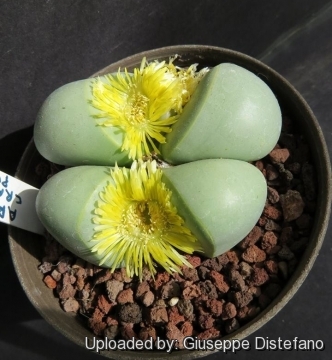 Field number PV 248 (Collector Petr Pavelka) Locality: 10km East of Bitterfontein. (Argyroderma crateriforme) Photo by: Giuseppe Distefano
Field number PV 248 (Collector Petr Pavelka) Locality: 10km East of Bitterfontein. (Argyroderma crateriforme) Photo by: Giuseppe Distefano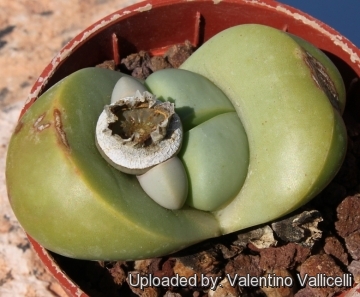 Mesembryanthemum crateriforme (Argyroderma crateriforme) Photo by: Valentino Vallicelli
Mesembryanthemum crateriforme (Argyroderma crateriforme) Photo by: Valentino Vallicelli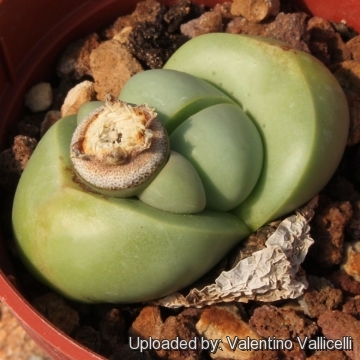 Mesembryanthemum crateriforme (Argyroderma crateriforme) Photo by: Valentino Vallicelli
Mesembryanthemum crateriforme (Argyroderma crateriforme) Photo by: Valentino Vallicelli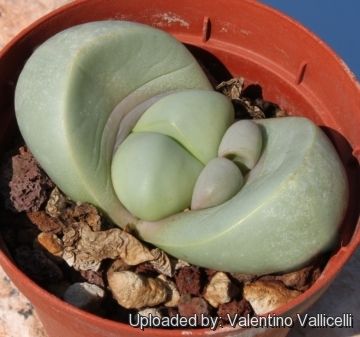 Mesembryanthemum crateriforme (Argyroderma crateriforme) Photo by: Valentino Vallicelli
Mesembryanthemum crateriforme (Argyroderma crateriforme) Photo by: Valentino Vallicelli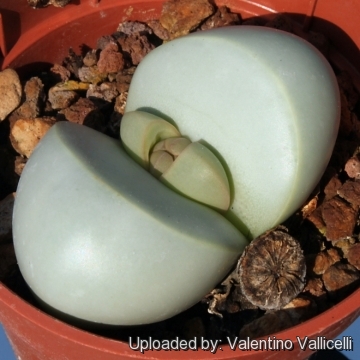 Mesembryanthemum crateriforme (Argyroderma crateriforme) Photo by: Valentino Vallicelli
Mesembryanthemum crateriforme (Argyroderma crateriforme) Photo by: Valentino VallicelliSend a photo of this plant.The gallery now contains thousands of pictures, however it is possible to do even more. We are, of course, seeking photos of species not yet shown in the gallery but not only that, we are also looking for better pictures than those already present.
Read More... Cultivation and Propagation: Argyroderma is easy to grow. Argyroderma are more forgiving than Lithops of excess water (though it should be rarely given in summer) and thrive in light winter rains in temperate climates and were heading for summer dormancy.
Soil requirements: It needs a very draining mineral, rather acidic, substrate. A mixture comprising 20 % pumice grit, 20% lava grit, 20% quartz grit, 20% coarse river sand and 20 % garden soil seems well suited.
Water needs: Requires little water otherwise its epidermis breaks (resulting in unsightly scars). Water minimally in summer, only when the plant starts shrivelling. But be careful with watering (rot sensitive).
Fertilization: Fertilize moderately during the growing season with diluted high potassium fertilizer.
Hardiness: It is fairly cold resistant and hardy to -5°C (or less if dry) depending on the clone.
Exposure: Need full sun, (with insufficient illumination bodies get thinner as a result of the lack of sun) but keep cool and shaded in summer,
Propagation: Seeds or division of larger clumps. Argyroderma is very easy to start from seed. Seeds germinate in 7-14 days at 21°C. Although they will start from cuttings, it is quite difficult to get them to root. If they start to rot there is usually part of the plant that can be removed and possibly rooted.
















